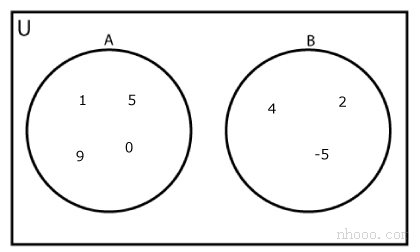编辑这个页面须要登录或更高权限!
- 您刚才的请求只有这个用户组的用户才能使用:自动确认用户
- 如果您还没有登录请登录后重试。编程那点事是一个开放式网站,修改本站大部分内容仅须要花10秒钟时间创建一个账户。 如果您已经登录,本页面可能是受保护的内容。如果您认为有修改的必要,请联系本站管理人员。
- 该页面已被锁定以防止编辑。
Python 集合 isdisjoint() 使用方法及示例
如果两个集合是不相交的集,isdisjoint()方法返回True。如果不是,则返回False。
如果没有公共元素,则将两个集合称为不交集。例如:
A = {1, 5, 9, 0}
B = {2, 4, -5}在这里,集合A和B是不相交的集合。

isdisjoint()的语法为:
set_a.isdisjoint(set_b)
isdisjoint()参数
isdisjoint()方法采用单个参数(一组)。
您还可以将一个可迭代的(列表,元组,字典和字符串)传递给isdisjoint()。isdisjoint()方法将自动将可迭代对象转换为set,并检查这些set是否不相交。
isdisjoint()的返回值
isdisjoint()方法返回
True 如果两个集合是不相交的集(在上面的语法中如果set_a和set_b是不相交的集)
False 如果两个集合不是不相交的集合
示例1:isdisjoint()如何工作?
A = {1, 2, 3, 4}
B = {5, 6, 7}
C = {4, 5, 6}
print('A和B不相交?', A.isdisjoint(B))
print('A和C不相交?', A.isdisjoint(C))运行该程序时,输出为:
A和B不相交? True A和C不相交? False
示例2:将isdisjoint()与其他Iterables作为参数
A = {'a', 'b', 'c', 'd'}
B = ['b', 'e', 'f']
C = '5de4'
D ={1 : 'a', 2 : 'b'}
E ={'a' : 1, 'b' : 2}
print('A和B不相交?', A.isdisjoint(B))
print('A和C不相交?', A.isdisjoint(C))
print('A和D不相交?', A.isdisjoint(D))
print('A和E不相交?', A.isdisjoint(E))运行该程序时,输出为:
A和B不相交? False A和C不相交? False A和D不相交? True A和E不相交? False
- Copyright © 2003-2013 菜鸟教程。
- 版权与免责声明
